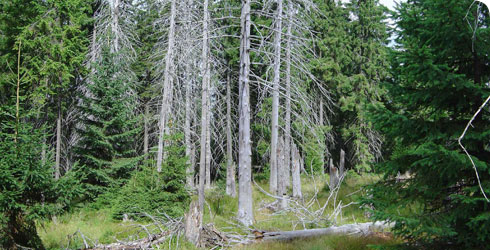Behaviour
Ips typographus is generally associated with damaged trees, windblown from gales or recently felled trees. If there is a plentiful source of this type of habitat, population numbers can increase rapidly, causing the beetles to move on to nearby healthy tree stands. It is at this point that the beetle becomes a serious pest.
Signs of infestation include:
- exit holes (2–3mm)
- frass - the debris left behind from the beetles’ excavation
- very small tubes of resin extruding from the bark
It is Ceratocystis polonica, a fungus carried by the beetle which causes blue stain in the spruce and causes the most severe damage, rather than the gallery boring itself. This blue stain fungus will kill healthy trees, and also stain the wood blue, thereby reducing the value of commercial stock. This is what makes this beetle a well-known economically important pest.
The damage becomes evident within a few weeks of infestation, and in standing trees needles will first turn yellow and then brown as they defoliate.
With global temperatures rising, this beetle can now inhabit altitudes beyond its original range (dispersal flights are initiated at 20°C and larval development as low as 8°C). This has implications for ecosystem management.
